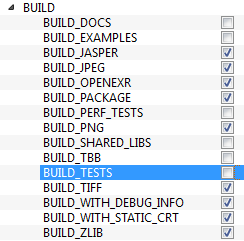OpenCV (Open Source Computer Vision) is a library of programming functions primarily aimed at real-time computer vision. OpenCV supports the deep learning frameworks TensorFlow, Torch / PyTorch and Caffe. Especially deep learning and Caffe is important in this Raspberry Pi project.
Install OpenCV
The first thing you should do is expand your filesystem to include all available space on your micro-SD card:
sudo raspi-config
Once prompted, you should select the first option, „1. Expand File System, hit Enter on your keyboard, arrow down to the „<Finish>“ button, and then reboot your Pi:
sudo reboot
After rebooting, your file system should have all available space on your micro-SD card. You can verify that the disk has been expanded by executing df -h and examining the output:
df -h
The size of the filesystem should be almost the same size as the size of the SD card.
Install dependencies
The first step is to update and upgrade any existing packages:
sudo apt-get update sudo apt-get upgrade sudo rpi update
Install some developer tools, including CMake, which helps to configure the OpenCV build process:
sudo apt-get install build-essential cmake pkg-config
Next, we need to install some image I/O packages that allow us to load various image file formats from disk. Examples of such file formats include JPEG, PNG, TIFF, etc.:
sudo apt-get install libjpeg-dev libtiff5-dev libjasper-dev libpng12-dev
Just as we need image I/O packages, we also need video I/O packages. These libraries allow us to read various video file formats from disk as well as work directly with video streams:
sudo apt-get install libavcodec-dev libavformat-dev libswscale-dev libv4l-dev sudo apt-get install libxvidcore-dev libx264-dev
The OpenCV library comes with a sub-module named highgui which is used to display images to our screen and build basic GUIs. In order to compile the highgui module, we need to install the GTK development library:
sudo apt-get install libgtk2.0-dev
Many operations inside of OpenCV (namely matrix operations) can be optimized further by installing a few extra dependencies:
sudo apt-get install libatlas-base-dev gfortran
These optimization libraries are especially important for resource constrained devices such as the Raspberry Pi.
Lastly, install the Python 2.7 or Python 3 header files, depending which Pyhton version you want to use. In this project we used 2.7:
sudo apt-get install python2.7-dev
OR
sudo apt-get install python3-dev
Download the OpenCV source code
Now it its necessary to install the desired version archive of OpenCV from the official OpenCV repository. In this case we took the version 3.4.1. The most recent version can be seen on the OpenCV website: https://opencv.org/
cd ~ wget -O opencv.zip https://github.com/Itseez/opencv/archive/3.4.1.zip unzip opencv.zip
We wanted the full install of OpenCV 3 so we also needed to grab the opencv_contrib repository as well:
wget -O opencv_contrib.zip https://github.com/Itseez/opencv_contrib/archive/3.4.1.zip unzip opencv_contrib.zip
Make sure your opencv and opencv_contrib versions are the same!
After that you have to install pip, a Python package manager and NumPy, a Python package used for numerical processing:
wget https://bootstrap.pypa.io/get-pip.py sudo python get-pip.py pip install numpy
Compile and Install OpenCV
First go to the directory of OpenCV then setup the build using CMake.
cd ~/opencv-3.4.2/ mkdir build cd build cmake -D CMAKE_BUILD_TYPE=RELEASE \ -D CMAKE_INSTALL_PREFIX=/usr/local \ -D INSTALL_PYTHON_EXAMPLES=ON \ -D OPENCV_EXTRA_MODULES_PATH=~/opencv_contrib-3.4.1/modules \ -D BUILD_EXAMPLES=ON ..
examine the output of CMake!
Start by scrolling down the section titled Python 2 and Python 3 .
If you are compiling OpenCV 3 for Python 2.7, then make sure your Python 2 section includes valid paths to the Interpreter , Libraries , numpy and packages path.
Finally, it is possible to compile OpenCV:
make -j4
The -j4 command controls the number of cores to leverage when compiling OpenCV 3
This step can take hours to finish.
After that OpenCv can be installed:
sudo make install sudo ldconfig
OpenCv should be installed now on the Raspberry Pi 3. To verify this use the ls command.
For python 2.7:
ls -l /usr/local/lib/python2.7/site-packages/
In some cases, OpenCV can be installed in /usr/local/lib/python2.7/dist-packages (note the dist-packages rather than site-packages . If you do not find the cv2.so bindings in site-packages , be sure to check dist-packages .
For python 3:
ls -l /usr/local/lib/python2.7/site-packages/



























